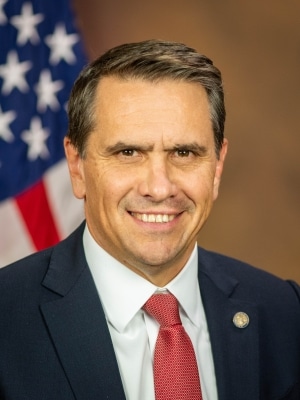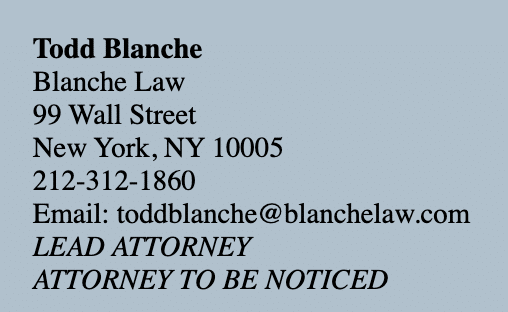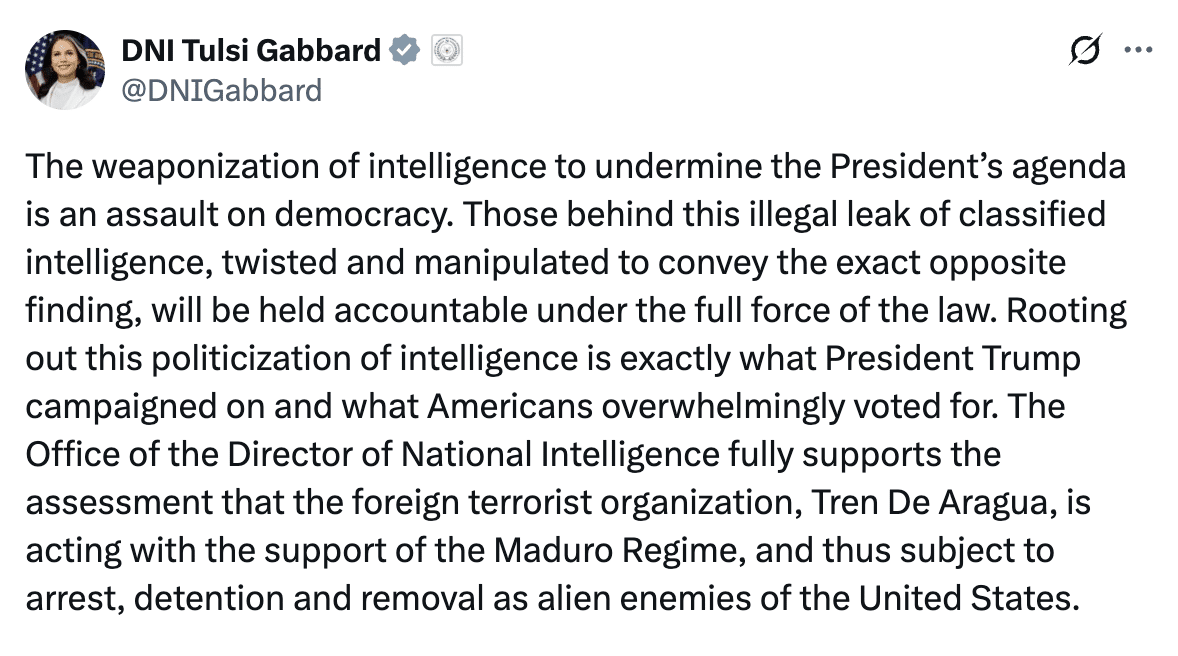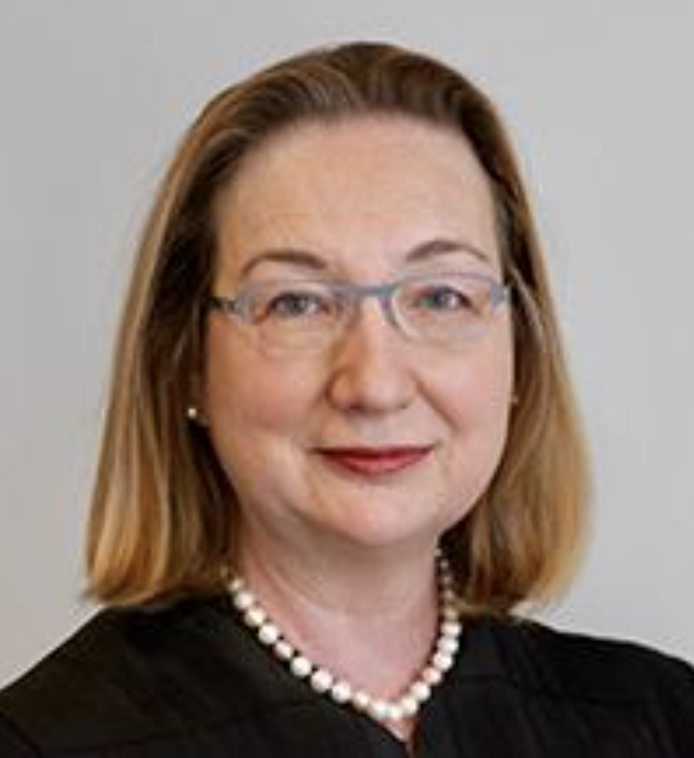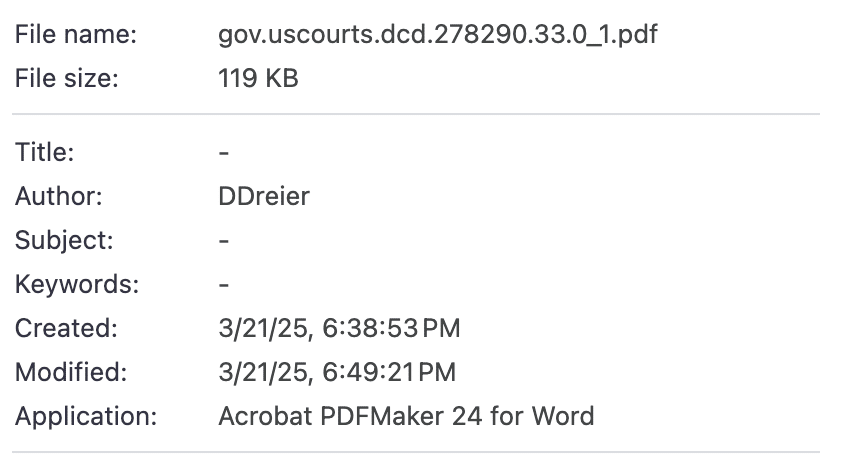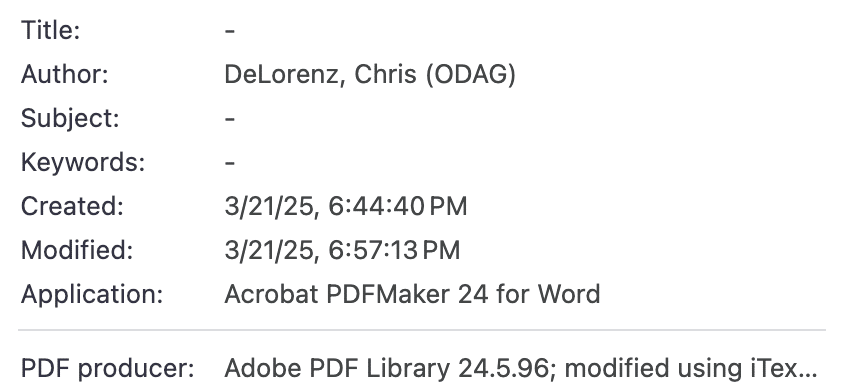A lifetime ago in the history of Stephen Miller’s dragnet (that is, Monday) I contemplated writing a post on how Magistrate Judge Barbara Holmes’ opinion — finding that DOJ was not entitled even to a hearing at which to argue in favor of detaining Kilmar Abrego Garcia pre-trial. but even if they were, that argument would fail — might influence his lawsuit in Maryland.
I got distracted with other things.
And now, it’ll be a dramatically different post. A bunch of things have happened in the interim, including:
- SCOTUS wrote an unfathomable order that got Trump’s DOJ off the hook for blowing off a District Court order by, instead, permitting Miller to deport migrants to slavery and torture (read Steve Vladeck for more)
- NYT published a story about a complaint Erez Reuveni submitted to DOJ Inspector General, alleging (in part) that, at a meeting about what to do in the face of an at-that-point-hypothetical order not to deport planeloads of migrants based on an Alien Enemies Act declaration, Emil Bove said “D.O.J. would need to consider telling the courts ‘fuck you’ and ignore any such order”
- Deputy Attorney General and sometime Trump defense attorney Todd Blanche went on a rant on Xitter, claiming newsworthy journalism (implicating him in alleged grave ethical violations) should not be “tolerated”
As it is, there are two key details from Holmes’ opinion that may have resonance both in KAG’s criminal case and the lawsuit.
Barbara Holmes: Is that your final answer?
She begins her opinion by noting that KAG is accused of human smuggling, not human trafficking.
To be clear, the offenses of which Abrego is charged are human smuggling, not human trafficking. Although “smuggling” and “trafficking” were sometimes used interchangeably during the detention hearing, there is a distinct difference between the two under the law. They are not transposable. According to the United States Citizenship and Immigration Services (“USCIS”) Policy Manual:
Federal law distinguishes between the crimes of human smuggling and human trafficking. Trafficking is a crime committed against a person regardless of the person’s immigration status or the crossing of a transnational border, while smuggling is a crime committed against a country’s immigration laws and involves the willful movement of a person across a country’s border.
A person may voluntarily consent to be smuggled. In contrast, an act of trafficking must involve both a particular means, such as the use of force, fraud, or coercion, and a particular purpose, such as subjection to involuntary servitude or a commercial sex act.
USCIS POLICY MANUAL, Difference Between Trafficking and Smuggling, Vol. 3, Pt. B, Ch. 2, § B.7, https://www.uscis.gov/policy-manual/volume-3-part-b-chapter-2. The Cornerstone Report,7 a quarterly bulletin highlighting key issues related to investigations by ICE Homeland Security Investigations (“HSI”), also explains the difference between human trafficking and human smuggling:
Human trafficking and human smuggling are often confused. The two crimes are very different and it is critical to understand the difference between the two.
Human trafficking involves exploiting men, women, or children for the purposes of forced labor or commercial sexual exploitation.
Human smuggling involves the provision of a service—typically, transportation or fraudulent documents—to an individual who voluntarily seeks to gain illegal entry into a foreign country.
The Cornerstone Report, Human Trafficking vs Human Smuggling, Vol. XIII, No. 1, Summer 2017, p.1. As the report states: “Smuggling is transportation-based. Trafficking is exploitation-based.” Id. “These are not interchangeable terms.” Id. [emphasis original]
The distinction matters for a key issue in the opinion, that even if there were minors present in a van KAG drove, that doesn’t necessarily make them victims of the crime.
Nevertheless, Holmes only returns to the issue of trafficking once more in her opinion, when pointing out that if the government had evidence of human trafficking, she hopes that DOJ would charge it.
The Court supposes – or at least hopes – that if children are victimized as part of their undocumented entry into this country, the government would pursue appropriate human trafficking charges against the human traffickers.
She makes a similar aside in her discussion of MS-13. KAG’s alleged gang membership is not charged. The only reason it was pertinent to a detention decision is in how it might substantiate a risk of obstruction. As Holmes laid out, the evidence that KAG actually was a member of MS-13 was weak hearsay.
The government’s evidence that Abrego is a member of MS-13 consists of general statements, all double hearsay, from two cooperating witnesses: the second male cooperator and N.V. Those statements are, however, directly inconsistent with statements by the first cooperator.
[snip]
Contrary to the statements of the second cooperator and NV, the first male cooperator told Special Agent Joseph that, in ten years of acquaintance with Abrego, there were no signs or markings, including tattoos, indicating that Abrego is an MS-13 member. This statement specifically repudiates any outward indicia that Abrego belongs to MS-13, in stark contrast to the non-specific second cooperator’s and N.V.’s feelings that Abrego may belong to MS-13. Given these conflicting statements, the government’s evidence of Abrego’s alleged gang membership is simply insufficient.
But even if KAG were a member of MS-13, that would only be relevant to the detention determination if he were trying to intimidate people because of that gang membership. And the vague allegations don’t get there, she says at the end of that passage.
Here, the government’s evidence of hearsay testimony of a cooperating witness’s general feeling of intimidation without any description of specific language used or actions taken by Abrego is not enough to establish by a preponderance that Abrego poses a serious risk of obstructing justice within the meaning of § 3142(f)(2)(B). 25
25 Given the volume of resources committed to the government’s investigation of Abrego since April 2025, according to Special Agent Joseph, the Court supposes that if timely, more specific, concrete evidence exists of Abrego’s alleged MS-13 gang membership or a consistent pattern of intentional conduct designed to threaten or intimidate specific individuals, the government would have offered that evidence at the detention hearing.
Which elicits a similar footnote as she made regarding trafficking: “If you had evidence of these things that might implicate the detention determination,” she seems to be saying about both trafficking and KAG’s alleged MS-13 membership, “you surely would mention it.”
As noted, those asides did have a role in the opinion (if not as big a one as the page-long discussion about the smuggling/trafficking distinction would seem to suggest).
But they’re important for another reason.
Holmes is basically noting that the government presented no evidence of two claims that top Administration officials, including Trump himself along with Pam Bondi, made repeatedly. The government didn’t share the doctored photo claiming KAG’s knuckles came coded for MS-13. The government presented no evidence that KAG was the threat Pam Bondi claimed he was.
Accumulating evidence about Trump and his top aides lying about KAG
The discrepancy between what the government said publicly and what they actually charged will presumably be the subject of a selective prosecution motion, as well as a slew of other efforts to preserve KAG’s right to a fair trial.
But the disjunct between what top Trump officials said publicly and what they’re willing to say in response to KAG’s lawsuit are a central prong of his motion for discovery sanctions in the lawsuit, which argues that the government is simply not cooperating with his ability to discover what happened regarding his detention. An exhibit, described as “a non-exhaustive list” of the public things that government officials said about KAG, quotes 21 allegations that KAG engaged in human trafficking and 60 claiming he was MS-13. As one example, it cites this screed from Stephen Miller in a press conference on May 1, at least a week after the grand jury already started investigating KAG.
There has been even more evidence that has been made public about [Abrego Garcia’s] violient [sic], repeated threats and assaults against his spouse, someone who had repeated documented human trafficking and human smuggling offenses, somebody that has extensively documented membership in MS-13, a terrorist organization, and of course someone [who] had MS-13 tattooed on his knuckles. This is a person who is a clear and present danger to the safety of the American people and it is a sad reflection on the state of our media and many of the outlets represented in this room that you incessantly try to shill for this MS-13 terrorist.
The filing compares public officials’ refusal to cooperate in discovery, their bogus privilege invocations, and depositions designed to obfuscate with this NY story (included as an exhibit as well), which describes emailed conversations about what to do with KAG that should be subject to the discovery order.
They use the article — for example — to argue that one of the people who did sit for a deposition, DHS Acting General Counsel Joseph Mazzara, “may have given untruthful testimony.”
More recently, credible press reports suggest that Mazzara—DHS’s Acting General Counsel—may have given untruthful testimony. At the deposition, Mazzara was asked whether he knew by April 12 [redacted]. He ultimately answered: [redacted] ECF No. 129-9 Tr. 76:9–13. When pressed about whether anyone at DHS [redacted] Mazzara claimed he had [redacted] Id. Tr. 155:10–7. According to the New York Times, however, Mazzara “told his colleagues that [DHS Secretary] Kristi Noem . . . had taken steps to seek Mr. Abrego Garcia’s segregation from other inmates, including members of Barrio 18.” See Ex. C. The report cites specific emails from Mazzara on or around March 28 in which he noted, “We’re also trying to keep him where he is.” Id. On March 30, James Percival, another custodian from whom Plaintiffs have received no documents,12 admitted that Abrego Garcia’s removal was “an administrative error,” but added: “(Not that we should say [so] publicly).” Id.
Another heavily redacted passage suggests that, based on how and when he was charged, DOJ lied about what Pam Bondi knew when.

The filing also compares what Noem and Bondi testified to Congress versus what the timeline of the criminal investigation shows actually happened.
That NYT article describes several conversations, involving but not limited to Erez Reuveni, about ways to fix the error of deporting KAG without endangering the deportation of the 200 other men that day. Reuveni was actually trying to mitigate the risk that the KAG case would endanger the larger argument about the Alien Enemies Act; as described, at least, he was trying to protect the decision to send 200 people to torture under the AEA.
As Mr. Reuveni pointed out to the group, the case potentially “jeopardizes many far more important initiatives of the current administration.” If the government fought and lost, it could have legal repercussions, not least of which for the nearly 140 Venezuelans who were sent to the same facility under the authority of a rarely used wartime law, the Alien Enemies Act of 1798.
That was where things stood two weeks ago, when KAG’s lawyers were asking for sanctions because of the secrets DOJ is hiding.
Reuveni ties DOJ’s actions with White House lies
Yesterday — the day before Emil Bove’s confirmation hearing to become a Circuit Court Judge — Reuveni submitted a whistleblower declaration to DOJ’s Inspector General, the Acting Special Counsel (who happens to be Trade Rep Jamieson Greer), and the leaders of House and Senate Judiciary Committees, which NYT was the first to report. As part of the complaint, Reuveni claims the public explanation Todd Blanche gave for why he was put on leave — because he was not zealously advocating for his client — is not the real reason. He says he was fired because he refused to implement commands to ignore court orders.
Since April 2025 it has been widely reported that according to DOJ sources Mr. Reuveni was put on administrative leave by DOJ for allegations offailure to follow directive from his superiors failure to zealously advocate on behalf of the United States and for arguing against Homeland Security and the State Department” when he truthfully represented to the court that Mr. Abrego Garcia’s removal was in error.² These statements by Attorney General Pamela Bondi and her deputy Todd Blanche are false and misleading Indeed it has since been reported that prior to the April hearing Senior Counselor to the Secretary of Homeland Security and Trump appointee James Percival conceded that Mr. Abrego Garcia’s removal was an administrative error (Not that we should say publicly.)
Nevertheless White House officials have publicly disparaged Mr. Reuveni to justify their refusal to comply with the Constitution and with court orders.4 White House Deputy Chief of Staff Stephen Miller falsely stated, “The only mistake that was made is lawyer put an incorrect line in legal filing,” and labeled Mr. Reuveni “saboteur, a Democrat.” 5 Referring to Mr. Reuveni, President Trump stated, “Well the lawyer that said it was mistake was here long time was not appointed by us—should not have said that should not have said that.”6
He cites more than the quote that Emil Bove said that they might have to tell courts “fuck you.” Reuveni claimed he defied three illegal orders:
- Trump’s DOJ blew off Judge James Boasberg’s injunction on deporting people under the Alien Enemies Act
- After Judge Brian Murphy issued a nationwide TRO on deportations without notice to involve a Convention Against Torture challenge, Reuveni was repeatedly admonished for trying to implement that injunction, in writing
- After correctly saying on April 4 that DOJ made a mistake when they deported KAG, Reuveni repeatedly objected and ultimately refused to sign an appellate brief claiming KAG was a terrorist (based on the MS-13 claim)
Reuveni’s description of the third illegal order describes how Drew Ensign responded when press headlines misrepresented Reuveni’s mere adoption of ICE’s admission that KAG was deported in error. Ensign scolded Reuveni twice, the second time, in response to a prompt from the White House.
A few minutes after the hearing, Mr. Reuveni went from the courtroom to the U.S. Attorney’s office space in the court building. The press had been present at the hearing, and bythe time he was leaving the courtroom, Mr. Reuveni had already received multiple text messages sharing news headlines about his statements to the court. Mr. Reuveni also received an email from Ensign directing Mr. Reuveni to call him, which Mr. Reuveni did. On that call, Ensign asked Mr. Reuveni – for the first time – why Mr. Reuveni had not argued that Mr. Abrego Garcia was a terrorist and that therefore his withholding ofremoval order was invalid. Mr. Reuveni told Ensign words to the effect of, “I understand you’ve seen the headlines, but read the transcript, I did not say the things the headlines say that I said.”
Ensign asked Mr. Reuveni why he did not argue that Mr. Abrego Garcia was a member of a terrorist organization or that being a member of such organization meant Mr. Abrego Garcia’s protection from removal to El Salvador was nullified. Mr. Reuveni told Ensign he did not make those arguments because: 1 ) those were not arguments in the government’s briefs, which Ensign had reviewed; 2) there was no evidence in the record to support the arguments; and 3) the laws governing withholding of removal do not support a theory that declaring someone a member of a terrorist organization retroactively nullifies a grant of withholding relief. Ensign had little reaction but called again a few minutes later asking similar questions and informing Mr. Reuveni that these inquiries were prompted by the White House. Mr. Reuveni again repeated the same concerns he had on the first call. [my emphasis]
Reuveni describes his repeated objections to an appeal claiming that KAG was MS-13 and therefore a terrorist. Hours after he refused to claim he was, Blanche put him on administrative leave.
Flentje told Mr. Reuveni that he should sign the brief, and that he had signed up for the responsibility to do so when he accepted the Deputy position. Mr. Reuveni responded, “I didn’t sign up to lie. ” Ultimately, someone else signed that brief, making arguments contrary to law, which was filed at 1:41 a.m. on April 5.
Less than seven hours later, Mr. Reuveni was placed on administrative leave for alleged “failure to follow a directive from your superiors; failure to zealously advocate on behalf ofthe United States; and engaging in conduct prejudicial to your client.” The letter signed by Deputy Attorney General Todd Blanche placing Mr. Reuveni on administrative leave was leaked to the press and reported that same day.51
Erez Reuveni claims that he was placed on leave (and ultimately fired) because he refused to lie and say there was evidence that KAG was an MS-13 member and therefore a terrorist.
Todd Blanche confesses he was in the thick of it all
The press focus on Reuveni’s complaint has been, justifiably given his confirmation schedule, on Emil Bove. Todd Blanche’s name appears just five times in the complaint, three times in association with a letter to him, the other two for his public claims about why Reuveni was fired. And Blanche’s name doesn’t appear at all in the appendix of public false claims top Trump officials have made about KAG.
But immediately after the NYT published its story, Blanche implicated himself personally, claiming to be at the meeting about the CECOT deportations and declaring taht public reporting of something newsworthy, “should not be tolerated.”
The New York Times article describes falsehoods purportedly made by a disgruntled former employee and then leaked to the press in violation of ethical obligations. The claims about Department of Justice leadership and the Principal Associate Deputy Attorney General are utterly false which is likely why the author gave the Department of Justice 15 minutes this morning to respond (they wrote that we did not “immediately respond with a comment”) before releasing this garbage. Note that [1] not a single individual except the disgruntled former employee agrees with the statements cavalierly printed by this purported news outlet. [2] I was at the meeting described in the article and at no time did anyone suggest a court order should not be followed. This is disgusting journalism. Planting a false hit piece the day before a confirmation hearing is something we have come to expect from the media, but it does not mean it should be tolerated.
Blanche’s claim that he was at that meeting conflicts with Reuveni’s; the whistleblower claims Bove was the senior DOJ official present.
That same day, following news reports that the President intended to sign a presidential proclamation invoking the Alien Enemies Act (AEA), Mr. Reuveni was summoned to a meeting by Deputy Assistant Attorney General (DAAG) of OIL, Drew Ensign. At the meeting were Principal Assistant Deputy Attorney General (PADAG) Emil Bove, Counselor to the Deputy Attorney General James McHenry, Associate Deputy Attorney General (ADAG) Paul Perkins, DAAG Ensign, Acting Director for OIL and Mr. Reuveni’s direct supervisor, August Flentje, and other OIL attorneys. [my emphasis]
That said, there’s a logical problem with Blanche’s claim. He clearly claims to have checked the story of the people who were in the meeting, marked with a [1] above. And then claims he was at the meeting, marked with a [2]. Those are the claims of a guy who has manufactured a cover story. Which — in light of the phone traffic documented by Reuveni that responded to his own emails — looks pretty suspect.
Remember: One of the very first public things Todd Blanche did as DAG was to launch a witch hunt into NYT’s source debunking Trump’s claims in the Alien Enemies Act. Then, when Pam Bondi reversed the media protections put into place by Merrick Garland, she cited that story as well. The seniormost officials at DOJ are using the Department to hunt down evidence of their own complicity in human rights violations. And Blanche’s intemperate response to Reuveni’s allegations looks to be more of the same.
It’s different with criminal prosecutions
Sadly, I don’t think the Reuveni allegations will have much impact on the Bove nomination. Right wingers in the Senate are all too happy to sanction Trump’s unprecedented corruption, as their confirmation of Blanche himself (to say nothing of Kash Patel) makes clear. I doubt that will change with Bove.
But it’s different for criminal defendants. By virtue of being criminally charged, rather than just suing for release, KAG can make a claim to need all of the conflicting stories about how top DOJ officials relayed demands and repeated false claims from people like Stephen Miller.
Perhaps that explains DOJ’s purported concern that if KAG is released pretrial, DHS might just deport him.
Nevertheless, a release of the Defendant into ICE custody poses potentially irreparable problems for the prosecution in this case and, therefore, for the public at large whose interests the Government serves. Should this Court not order a stay, and the Defendant is moved to ICE custody and deported from the United States, the prosecution would lose the meaningful opportunity to try its case. This would be irreparable harm to the public. How fast the Defendant could or would be deported remains to be seen. In candor with the Court, such a potential deportation of the Defendant would not be instantaneous. How fast such proceedings could move are difficult to predict. Yet, these immigration proceedings exist as real, potential, substantial and irreparable harm to the United States.
DOJ has made its problems so much worse by refusing to do the right thing with KAG and the CECOT deportees.
And because they’ve charged KAG, that may actually finally backfire.
Update: In the DVD case (the one in which SCOTUS ruled on Monday), plaintiffs are asking to file a surreply describing Reuveni’s allegations.
Just yesterday, a former high-level official with the Department of Justice’s Office of Immigration Litigation filed a protected whistleblower claim alleging that in this very case, highlevel Department of Justice officials conspired to violate the district court’s temporary restraining order (TRO). The disclosure describes, in painstaking detail, efforts to feign ambiguity in an unambiguous order, failing to disseminate the fact and terms of the injunction, and purposefully failing to respond to Plaintiffs’ inquiries. See Protected Whistleblower Disclosure of Erez Reuveni Regarding Violation of Laws, Rules & Regulations, Abuse of Authority, and Substantial and Specific Danger to Health and Safety at the Department of Justice at 16-21, https://s3.documentcloud.org/documents/25982155/file-5344.pdf.1

